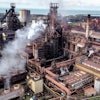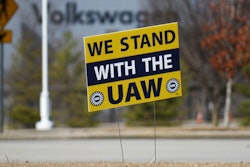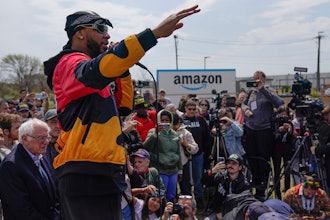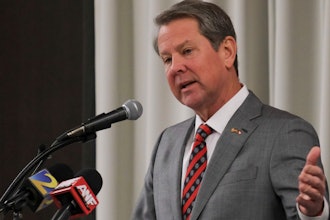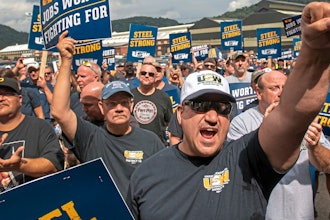JOLIET, Ill. (AP) -- Four years ago, then-U.S. Sen. Barack Obama called them "veterans of the Cold War" and pledged to help them receive compensation.
But today, many former workers at Blockson Chemical Co. in Joliet and their survivors still have not been paid from a fund created in 2000 to make amends for exposing the workers to high levels of radiation without telling them or providing adequate protection.
Among them is Phyllis Keca, 84, whose husband, John, thought he was manufacturing laundry detergents during his 23 years working at Blockson. He wore only a paper mask while handling tanks that, unknown to him, were filled with uranium and radium to be used in the production of nuclear weapons.
He was "always sick," his wife said, and would come home covered in dust that she now believes was toxic and contributed to his death in 1996 from colon cancer at age 80.
"It's deceitful and it's deceiving because my husband went through so much," said Keca, who lives in Joliet just a few miles from where her husband once worked. "They made us feel like they were promising us something and then reneged."
That could change in the coming weeks, however. By early September, federal officials are expected to decide on a special petition filed on behalf of former Blockson Chemical workers and their survivors who not only struggled with radiation-induced cancer but also with a complex federal bureaucracy.
The petition would make it easier for Blockson employees to file claims by eliminating the requirement that they prove their illnesses were radiation-related.
"These are situations involving people who have waited for years to get a fair shake by the system, and we want to do the best we can to make sure they get that," said Fred Blosser, a spokesman for the National Institute for Occupational Safety and Health, which helps administer the program.
At stake are claims filed on behalf of former Blockson Chemical workers who helped build atomic weapons at the facility from March 1, 1951, to June 30, 1960.
Blockson employees were among more than 600,000 industrial workers nationwide who helped build and test nuclear weapons for the federal government during and after World War II.
In 2000, Congress established a fund to give $150,000 plus medical benefits to workers who got certain cancers caused by handling radioactive materials. In cases where the workers had died, the money would be paid to their survivors.
But the pace of payouts has been slow and the burden of proof has been high. Of 363 claims filed on behalf of Blockson workers or their relatives, 102 have been paid thus far, according to Department of Labor statistics.
Of 5,170 claims filed on behalf of former workers at 29 eligible facilities in Illinois, 1,250 have been paid by the fund, known as the Energy Employees Occupational Illness Compensation Program.
Under the petition filed on behalf of Blockson employees, former workers need a doctor's report verifying they had one of several specific types of cancers including colon cancer but they do not need to prove that the illness was radiation-related.
That would allow petitioners to circumvent the time-consuming process known as "dose reconstruction" a complex formula used by federal officials in most compensation cases, including many Blockson claims, to estimate the type and level of radiation exposure to each of the workers' organs affected by cancer.
Former Blockson workers have argued that dose reconstruction is impossible because neither the government nor the chemical company adequately monitored the facility for radiation levels.
Dose reconstruction is largely why former workers have become frustrated by the compensation program, said Dennis J. Kellogg, a Chicago attorney who represented more than 20 Blockson workers.
"I think the intention (of the compensation program) was great, but the bureaucracy took over and the intent got buried in the details," he said.
In addition, many former workers and their families have been kept in the dark about the status of their claims, according to a Government Accountability Office report released in March.
"As a result of the many years of secrecy, the lack of information, and the years of denial that their conditions were related to exposure, many claimants find it difficult today to trust that the federal government is fairly evaluating their claims," the report said.
In the 1950s, the nation's nuclear program was kept top-secret because of national security concerns. Workers were given little, if any, information about the radioactive materials they handled and its potential hazards.
After the fund was established, Phyllis Keca filed a claim, beginning a nine-year correspondence with the federal government that she keeps in a 4-inch-thick binder. After each letter she sent, the government responded with a letter requesting more health records from when her husband worked at Blockson, she said.
"Trying to go back that far to get any kind of information is hopeless," Keca said. "That's what they want you to do. They want you to try to get something that is hopeless."
In 2006, then-Sen. Obama held a meeting in Naperville with former Blockson workers and their families to hear their frustrations and publicly urge the federal advisory board deciding their petition to expedite the process.
"It's important, from my perspective, to light a fire under (the board) and let them know we expect them to provide a just decision and do it quickly," Obama said at the time.
Last year, after becoming president, Obama appointed four new members to the Advisory Board on Radiation and Worker Health. In July, the board broke its long deadlock on the Blockson petition and recommended its approval to the secretary of the Department of Health and Human Services. If approved by the secretary, former Blockson workers or their survivors could receive compensation by this fall, federal officials say.
There are 27 other sites where former workers have filed petitions that are still pending.
"We expect a significant number of Blockson workers or their survivors to be able to now get compensation once the petition is fully approved," said James Melius, chairman of the Advisory Board on Radiation and Worker Health.
Tony D'Atri, 86, worked at Blockson from 1947 to 1968 and for a short time at Argonne National Laboratory, where federal officials say employees were at risk of beryllium exposure.
D'Atri later lost a 12-inch section of his colon to cancer. He walks with a cane around his small house in Elwood, just a few miles south of the former Blockson plant. He receives an annual colonoscopy. His medical bills have been paid either out of pocket or through his insurance company, he said.
D'Atri said his claim for compensation has been evaluated three times. The last evaluation determined he was just shy of the amount of radiation exposure needed to receive payment, he said.
If he gets paid by the federal government, he will turn over the money to his kids because he is too old and frail to use it himself, he said.
"I don't care so much about the money," D'Atri said. "I just want to be recognized for what I did."
After 10 years of waiting, Keca is skeptical that the federal government will finally pay her. But if the money does arrive, "it would make life a little more pleasant," she said.
"I could stop counting pennies," she said.



